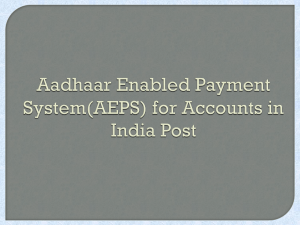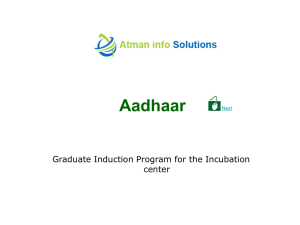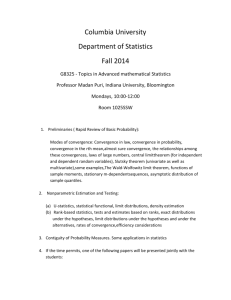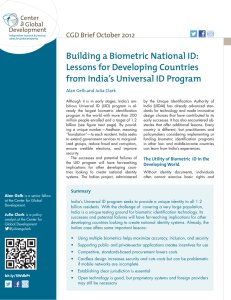UIDAI Taps IoE Capabilities to Improve Service Delivery and Cut Costs Background
advertisement
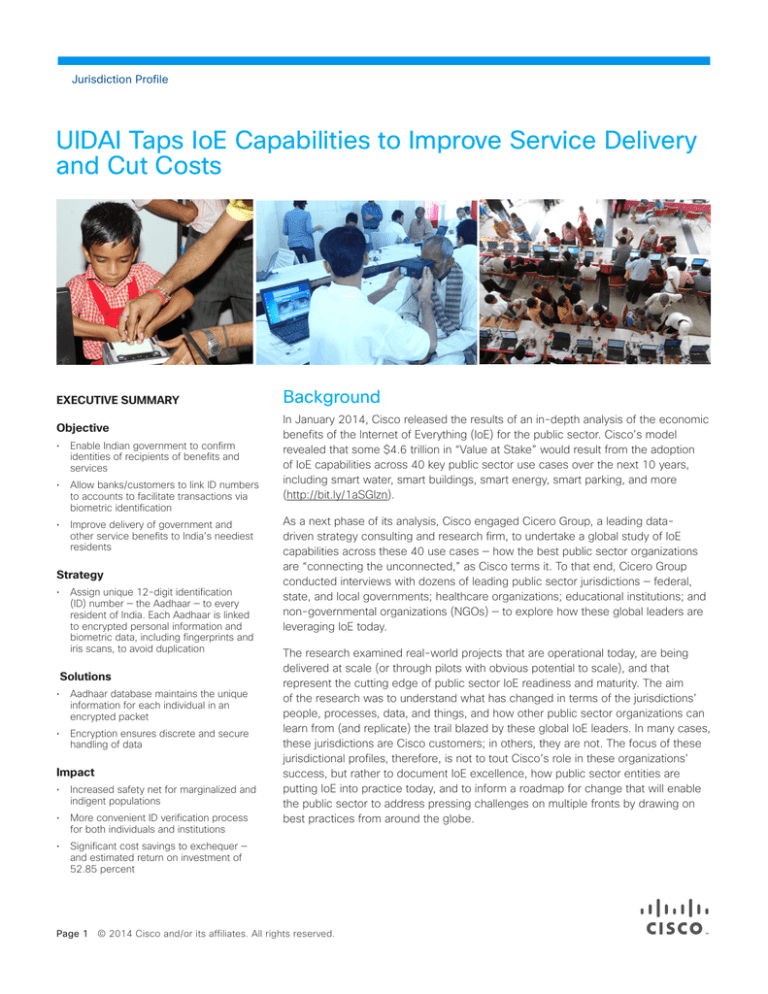
Jurisdiction Profile UIDAI Taps IoE Capabilities to Improve Service Delivery and Cut Costs EXECUTIVE SUMMARY Objective • Enable Indian government to confirm identities of recipients of benefits and services • Allow banks/customers to link ID numbers to accounts to facilitate transactions via biometric identification • Improve delivery of government and other service benefits to India’s neediest residents Strategy • Assign unique 12-digit identification (ID) number — the Aadhaar — to every resident of India. Each Aadhaar is linked to encrypted personal information and biometric data, including fingerprints and iris scans, to avoid duplication Solutions • Aadhaar database maintains the unique information for each individual in an encrypted packet • Encryption ensures discrete and secure handling of data Impact • Increased safety net for marginalized and indigent populations • More convenient ID verification process for both individuals and institutions Background In January 2014, Cisco released the results of an in-depth analysis of the economic benefits of the Internet of Everything (IoE) for the public sector. Cisco’s model revealed that some $4.6 trillion in “Value at Stake” would result from the adoption of IoE capabilities across 40 key public sector use cases over the next 10 years, including smart water, smart buildings, smart energy, smart parking, and more (http://bit.ly/1aSGIzn). As a next phase of its analysis, Cisco engaged Cicero Group, a leading datadriven strategy consulting and research firm, to undertake a global study of IoE capabilities across these 40 use cases — how the best public sector organizations are “connecting the unconnected,” as Cisco terms it. To that end, Cicero Group conducted interviews with dozens of leading public sector jurisdictions — federal, state, and local governments; healthcare organizations; educational institutions; and non-governmental organizations (NGOs) — to explore how these global leaders are leveraging IoE today. The research examined real-world projects that are operational today, are being delivered at scale (or through pilots with obvious potential to scale), and that represent the cutting edge of public sector IoE readiness and maturity. The aim of the research was to understand what has changed in terms of the jurisdictions’ people, processes, data, and things, and how other public sector organizations can learn from (and replicate) the trail blazed by these global IoE leaders. In many cases, these jurisdictions are Cisco customers; in others, they are not. The focus of these jurisdictional profiles, therefore, is not to tout Cisco’s role in these organizations’ success, but rather to document IoE excellence, how public sector entities are putting IoE into practice today, and to inform a roadmap for change that will enable the public sector to address pressing challenges on multiple fronts by drawing on best practices from around the globe. • Significant cost savings to exchequer — and estimated return on investment of 52.85 percent Page 1 © 2014 Cisco and/or its affiliates. All rights reserved. Jurisdiction Profile About the UIDAI Aadhaar Project The Unique Identification Authority of India (UIDAI) began the Aadhaar project in 2009 with a goal of assigning a unique identification (ID) number to every resident of India. Each 12-digit ID, or Aadhaar, is linked to encrypted personal information and biometric data, including fingerprints and iris scans, to avoid duplication. The ID numbers and attached biometric data will help the Indian government confirm the identities of recipients of benefits and services. The numbers are also being used by banks and by those participants who link the ID number to their bank accounts to facilitate transactions via biometric identification. While still in an early phase, it is anticipated that institutions and vendors around the country will begin to increasingly accept the Aadhaar and biometric identification as a payment mechanism. “The vision of the UIDAI is to empower the residents with a unique identity that is valid across the country, and to create a digital platform where these identities can be authenticated on an anytime/anywere basis, instantaneously.” Vijay Madan, Director General and Mission Director, Unique Identification Authority of India As director general and mission director of the Unique Identification Authority of India, Vijay Madan oversees the Aadhaar project. Mr. Madan is 33-year veteran of the Indian Administrative Service and has also served as the chief of economic policy in the Air Transport Bureau of the International Civil Aviation Organization (ICAO), a specialized agency of the United Nations. Since its inception in 2009, UIDAI has issued more than 620 million Aadhaar numbers, although, Mr. Madan noted, “The enrollment numbers, impressive as they may be, have so far covered only a little more than 50 percent of the country’s population.” Having ramped up the system and currently operating at full capacity, UIDAI hopes to issue the one billionth card sometime in 2015. Objectives The UIDAI program was originally conceived as a way to facilitate delivery of government and other service benefits to the country’s neediest residents, many of whom lack a fixed address or verifiable birth document required by prior systems. “[The government] went into it initially as an identity for specific groups who are marginalized, socioeconomically disadvantaged groups,” Mr. Madan explained. “That was the vision with which it was started, and the idea was to be able to use these identities for a variety of purposes — most importantly, to catalyze financial inclusion and to act as a tool for efficient and effective delivery of services and benefits. A unique identity is likely to help with that in the sense that it’s known exactly who is trying to access the service, at what point, from where. Then it was realized that because of the movement of people, doing it on a partial basis and not the entire country would not solve the problem entirely. The scope was expanded to include all residents.” For Aadhaar to work, it had to address the issues with previous ID systems: geographic restrictions and language barriers. Additionally, previously used cards or certificates were particularly susceptible to fraud. Mr. Madan said that Aadhaar’s biometric identifiers are much more difficult to fake and can be compared for duplicates upon enrollment. “The vision of UIDAI is to empower the residents with a unique identity that is valid across the country, and to create a digital platform where these identities can be authenticated on an anytime/anywhere basis, instantaneously,” Mr. Madan explained. Page 2 © 2014 Cisco and/or its affiliates. All rights reserved. Jurisdiction Profile Mr. Madan indicated that while enrollment in the ID system is voluntary, it is hoped that an understanding of the program’s benefits will provide an incentive for participation. Adding to the scale of the project, Mr. Madan indicates the ID program is designed not just for adults, but children as well. Strategy Mr. Madan described the massive effort to reach each member of the population, including walk-in services at government and non-governmental agencies; a census-type, house-to-house enrollment; and an “introducer-based” system that allows a referral from designated introducers, who accompany those residents unable to verify a fixed address. “We work through 70 registrars, and these registrars engage about 200-plus enrollment agencies, and there are about 25,000 to 27,000 operators working the field. The people at each station do about 40 to 50 enrollments per day. So roughly, we have about a million-plus enrollment possibility per day — 1 to 1.2 million.” “We work through 70 registrars, and these registrars engage about 200-plus enrollment agencies, and there are about 25,000 to 27,000 operators working the field. The people at each station do about 40 to 50 enrollments per day. So, roughly, we have about a million-plus enrollment possibility per day — 1 to 1.2 million.” Vijay Madan, Director General and Mission Director, Unique Identification Authority of India UIDAI engages in extensive public outreach and education regarding the ID system, including broadcast, print, and all types of media. “This is a voluntary program, so we ... let people know that we are doing the enrollment in a particular area,” Mr. Madan explained. “The initiative of coming and enrolling for that is entirely with the individual residents. There are places where, of course, the demand is very high and we have to make arrangements to ensure that the systems run smoothly and people don’t have to wait unnecessarily.” According to Mr. Madan, public education efforts emphasize the benefits and services available for participation; they point out “how [Aadhaar] becomes a tool of convenience for [residents], whether it is in terms of dealing with their financial institutions or dealing with the banks or dealing with any other institution that they may be a part of, and particularly in the financial institutions and most of the regulatory authorities.” UIDAI has established a number of working groups and subcommittees to address outreach and education. Mr. Madan stated that costs in the five years since the project launched have totaled 40 billion INR, or roughly US$670 million. In fiscal year 2013, UIDAI’s operational budget was 15 billion INR, or roughly US$250 million. Solution Aadhaar Registration Mr. Madan described the Aadhaar database as a simple and secure system that keeps only the unique information for each individual in an encrypted packet, with no associated data, such as access history. “This data — name, age, gender, date of birth, address, photograph, two iris images, and 10 fingerprints — together form one packet for enrollment. In addition, on an optional basis, [the applicant] could also give his mobile number and email ID, and we do encourage that they do so, because it can be easier for them later to be able to get the information from UIDAI regarding when the Aadhaar is generated or for any authentication that is done subsequently.” Page 3 © 2014 Cisco and/or its affiliates. All rights reserved. Jurisdiction Profile In addition to supplying existing forms of ID, residents must verify a home address, if possible. Mr. Madan explained that more than 30 documents, such as utility bills, are acceptable as a proof of address. For those with no fixed address, such as nomadic populations or the homeless, the system allows referral-type “introducer-based” verification from 3,700 officially recognized introducers throughout the country. Mr. Madan explained that to date, this type of enrollment represents less than one half of 1 percent of the total. UIDAI also partners with the Registrar General of India — who also operates the National Population Register, the country’s census organization — for houseto-house contact. “They have a slightly different process because they adopt an areawide approach for any locality,” Mr. Madan explained. He said that data gathered by these representatives also includes the limited information required for issuance of the Aadhaar card. Mr. Madan exphasized that protection of the individual’s privacy is a top priority built into the system. Data Security and Privacy Mr. Madan emphasized that protection of the individual’s privacy is a top priority built into the system. “As soon as this packet is prepared at the enrollment station, it becomes encrypted,” he said. “This encrypted package then reaches the Central Identities Data Repository (CIDR), our official back-end facility where all these are processed. Each one of the iris and fingerprint images is matched with those of the previously enrolled people. For example, today each one such would be compared with the 620 million sets of biometric information that we already have, plus the ones that are being processed on that day. If it is found to be unique, then an Aadhaar number is generated for that person.” According to Mr. Madan, each agent is properly trained and certified to conduct enrollments, and agents must enter their credentials with each application packet to create a traceable record. Each packet is subsequently encrypted and inaccessible to the agent throughout the uploading process to the CIDR. “It’s a very secure and a technologically high-end kind of a system where the [agent], while he is doing it, has a specific window in which he can do whatever he can do, but he doesn’t have visibility to do this sort of thing before or after. Once encryption takes place, it’s controlled by us.” The system is self-cleansing, with submissions purged from individual hard drives upon uploading to the CIDR. Because enrollment often occurs in areas without data connectivity, agents sometimes must travel to an area with connectivity to complete the uploading process. “Within a period of 20 days, [the agent] must upload the entire data. After the packet has been received and it has been processed, in a subsequent sync we will control the purging of the data from those specific client machines.” Mr. Madan said that data security policies are in place within the CIDR as well. “The security in terms of holding the information on behalf of the individual is something that the organization obviously takes very seriously, and all effort is made to keep it completely secure and private,” Mr. Madan explained. “When we maintain it in the CIDR, it is encrypted, and in any authentication process we do not share the data unless there is a specific consent given by the resident. That also applies only if he Page 4 © 2014 Cisco and/or its affiliates. All rights reserved. Jurisdiction Profile When a bank, for example, wants to verify someone’s identity, the person provides his or her number and biometric information, such as a fingerprint or iris scan, and the bank then sends the request to the CIDR. Comparing the data on a 1:1 basis in the CIDR is highly efficient — it provides a brief yes/ no response that is then sent back to the institution requesting the identity check. wants his demographic data and a photograph. The biometric data is not shared at all with any organization.” Mr. Madan further explained the discrete and secure handling of data within the Aadhaar system. When a bank, for example, wants to verify someone’s identity, the person provides his or her number and biometric information, such as a fingerprint or iris scan, and the bank then sends the request to the CIDR. Comparing the data on a 1:1 basis in the CIDR is highly efficient — it provides a brief yes/no response that is then sent back to the institution requesting the identity check. “The identity platform keeps the data collected from the individual to the bare minimum,” Mr. Madan stated. “There is no intelligence built into the number, and no profiling data is collected at all. In the process of linkage, while the unique identifier can be used by various programs, the reverse data is never collected by UIDAI. The information about the individual remains with the specific departments alone, and any process of sharing of data from one such program to another department will continue to follow the usual processes of law. Therefore, the data remains segregated and federated.” Figure 1. UIDAI: New and Better Connections. Source: Cisco Consulting Services, 2014 Impact Increased Access to Benefits Mr. Madan emphasized that the original goal of the project was to provide an increased safety net for marginalized and indigent populations. Because the program was designed for the inclusion of these groups, he is hopeful that Aadhaar will encourage increased participation rates in services offered by both government and private assistance and service programs. Page 5 © 2014 Cisco and/or its affiliates. All rights reserved. Jurisdiction Profile Convenience Mr. Madan stressed that a primary goal of the Aadhaar system is to make ID verification more convenient for both individuals and institutions. This is particularly important for industries governed by regulatory authorities, such as financial institutions and insurance companies, which routinely require verifiable customer identification. Mr. Madan said that Aadhaar includes the technological capacity to be linked to a bank account. More than 67 million Aadhaar number holders have linked their bank accounts to their Aadhaar. The Aadhaar number is accepted by a broadly used system — the Know Your Customer program, or KYC, a tool used by banks, financial institutions, retailers, and other institutions for customer verification. He indicated that the electronic version of this system, the eKYC, is enabled by the Aadhaar program and is gaining in popularity. It is now accepted for participation in transactions with the State Bank of India — the country’s largest financial institution — and with institutions regulated by the National Insurance Regulator, the Provident Fund regulator, and various other agencies. Mr. Madan believes the Aadhaar’s potential to prevent waste and discourage error will also result in a significant cost savings to the exchequer. He referred to a cost benefit analysis of the program by the National Institute of Financial Planning and Policy, which estimated the eventual rate of return on investment for the program as 52.85 percent. Mr. Madan indicates inclusion in the eKYC system is a significant benefit for Indian residents. “Since customer verification actually takes quite some time if not done through an electronic route, the biggest advantage of the authentication service is that it saves a lot of time. With the Aadhaar, service delivery can take place almost instantaneously. This is important, for example, in situations such as opening new bank accounts — it’s a very powerful tool. This is what has made Aadhaar a very potent tool for financial inclusion, and that is one of the major areas in which it is being leveraged.” Cost Savings Mr. Madan believes the Aadhaar’s potential to prevent waste and discourage error will also result in a significant cost savings to the exchequer. He referred to a cost benefit analysis of the program by the National Institute of Financial Planning and Policy, which estimated the eventual rate of return on investment for the program as 52.85 percent. Mr. Madan acknowledged that exact numbers are difficult to estimate, but that all indications for significant savings are promising. “There are different kinds of estimates as to how much leakage and waste exists,” he explained. “They could range from 10 percent to 15 percent or even 20 percent in some of the programs, and they may be a little less in the other programs. On average, if it is taken as about 10 percent savings on all schemes run by the federal government for a direct benefit or subsidies, then the whole thing works out to really huge sums. But again, as I said, these are assessments. The assessment of the total contribution of various kinds of services and benefits that Aadhaar could bring on the table could amount to a savings to the exchequer to the extent of about half a percent of the gross domestic product. For a $2 trillion economy, that’s a huge sum of money.” Page 6 © 2014 Cisco and/or its affiliates. All rights reserved. Jurisdiction Profile Lessons Learned / Next Steps The biggest challenge of the Aadhaar project, according to Madan, is its ambitious scale. “It is a huge challenge because of the number of people being enrolled on a daily basis, but that’s a continuing kind of thing, and any large program released to the public has to have these kind of things organized.” There has been negative press, with concerns over privacy and civil rights constituting the majority of complaints, even within the government. A parliamentary committee recently attacked the Aadhaar system, calling it “directionless” and “full of uncertainty.” Critics note the absence of sufficient privacy laws and call for clarification as to how the government will use the information and who will be able to access it. Mr. Madan advises those seeking to deploy a similar system to build simplicity and security into the program architecture. . However, the system also receives many positive reviews among those closely studying the program. UIDAI received the 2013 DSCI Excellence award for Security in E-Governance. DSCI’s website notes the following: With the inherent complexity involving multiple partners, agencies, registrars, and users, and multiple access modes with an unparalleled number of data records, UIDAI has implemented a holistic approach for identifying and addressing security concerns which includes principles, policies, technology, and architectural aspects. Mr. Madan indicated that while educating the public has required huge outreach, significant effort has also been expended in gaining the support of institutions that may benefit from Aadhaar’s services. Mr. Madan explained that those institutions still holding out “are not really looking at it as a benefit from the government.” Outreach efforts seek “to carry the understanding of what is possible, and to leverage this for reengineering processes — followed by any department, service provider, or benefits-granting department dealing efficiently and effectively with their clientele to work out different kinds of applications.” Mr. Madan advises those seeking to deploy a similar system to build simplicity and security into the program architecture. “The system design has to be such that you are taking the minimum amount of data, and basically use the identity platform only for verification of the identity of the individual and not mix it up with any other process,” he explained. Mr. Madan indicates that keeping data fresh and updated — a process he refers to as “updation” — is a matter of ongoing study and development. “Any system is only as good as its accuracy, and in this kind of a database, even though we collect only four basic fields — name, age, gender, and address — two of them that are subject to change. People do change their names, particularly after events like marriages, and people routinely change their addresses. Also, their photographs will change after a few years, so there is a constant need for updation of this data.” Page 7 © 2014 Cisco and/or its affiliates. All rights reserved. Jurisdiction Profile Mr. Madan continues to work both in the field with residents and to bring institutions onboard. He sees a huge potential for application of the program in many aspects of society. “There are a number of applications in the non-financial sector where identity is required to be proven — for example, with new mobile connections,” he said. “These kinds of things, once they start getting linked to this identity, will be another area that will be on an ongoing basis. It will be ever-expanding and developing, evolving those programs and applications to the best usage or the convenience of the user as well as [contributing to] better efficiency by the service provider.” Mr. Madan acknowledges Aadhaar as “transformational,” saying, “It will evolve, obviously, with time. What we are looking at now is just the beginning of it, and over a period of years, this has immense capacity for [contributing] a variety of conveniences, in terms of benefits, in terms of what can be done with this.”

